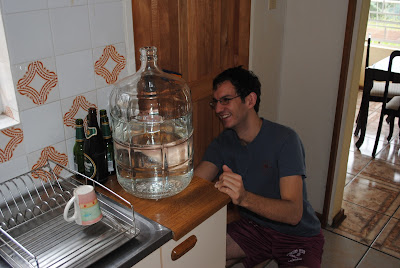Dear Friends and Family:
A quick note to pass along some pictures from the three-day mountain bike race that I rode last month with my friend Antz in the northwestern (and very mountainous) part of Swaziland.

The contour maps of the race are here: http://www.theswazifrontier.sz/pages/maps.htm. It was definitely the most physically challenging thing I've ever done. In total, we rode 180 kilometers over three days, with a total riding time of nearly 25 hours. We didn't finish in last place, but we were pretty close. Out of the 90 teams that started, 10 didn't finish at all, though, so we can put that notch in our belts.
A quick note to pass along some pictures from the three-day mountain bike race that I rode last month with my friend Antz in the northwestern (and very mountainous) part of Swaziland.
The contour maps of the race are here: http://www.theswazifrontier.sz/pages/maps.htm. It was definitely the most physically challenging thing I've ever done. In total, we rode 180 kilometers over three days, with a total riding time of nearly 25 hours. We didn't finish in last place, but we were pretty close. Out of the 90 teams that started, 10 didn't finish at all, though, so we can put that notch in our belts.
Day one we took a 90-minute detour, and the first picture of me pushing the bike up the hill is at the top of "too brutal" which you can see on the map linked above. That's Antz riding behind me, but for the record, he started riding at precisely that spot. Like me, he'd been pushing for the last three uphill kilometers or so.
Grandpa Ken, if you look closely at the first picture, you can see which jersey I was wearing on day 1. Everyone thought I was the representative from Canada that day, though in reality that was some other guy who had flown in for the ride.
At that point, we'd been on our bikes for nearly 10 hours, but somehow still relatively happy. I guess we were close to home by then.
Pictures two, three and four are of a river-crossing challenge on the second day, it was 20-30 yards across, and two to three feet deep in the middle. The goal was to ride without putting your feet down (picture 2). I made it within 10 feet of the edge before tipping over (pictures 3 and 4), but ended up in the water anyway.
Pictures two, three and four are of a river-crossing challenge on the second day, it was 20-30 yards across, and two to three feet deep in the middle. The goal was to ride without putting your feet down (picture 2). I made it within 10 feet of the edge before tipping over (pictures 3 and 4), but ended up in the water anyway.
We got progressively better over the course of the three days. Everyone was surprised to see us at the finish line on day three as early as we were. Our friends waiting for us at the finish had been told that we would likely arrive an hour later than when we did, so there's small consolation in that. I have a picture from the finish, but it's not with me now. I'll try to post it later on.
Happy early Thanksgiving to all (or late thanksgiving, to the Canadians, I suppose). We're celebrating at a different friend's house this year, but the plan is still to collaborate to cook up four turkeys and all the sides for a cast of thousands. With luck, we'll project tonight's Patriots-Chiefs game on the wall, since watching it live isn't possible with an 8-hour time lag.
Garrett
















